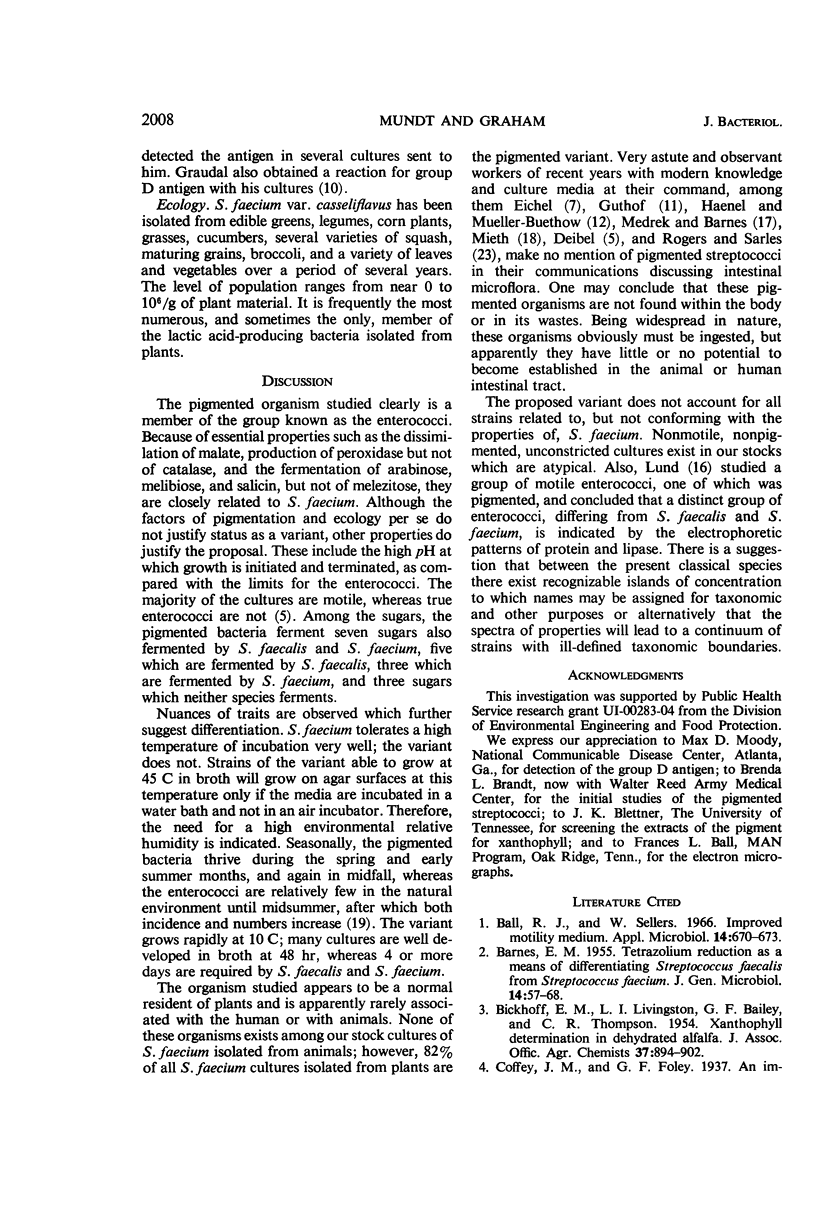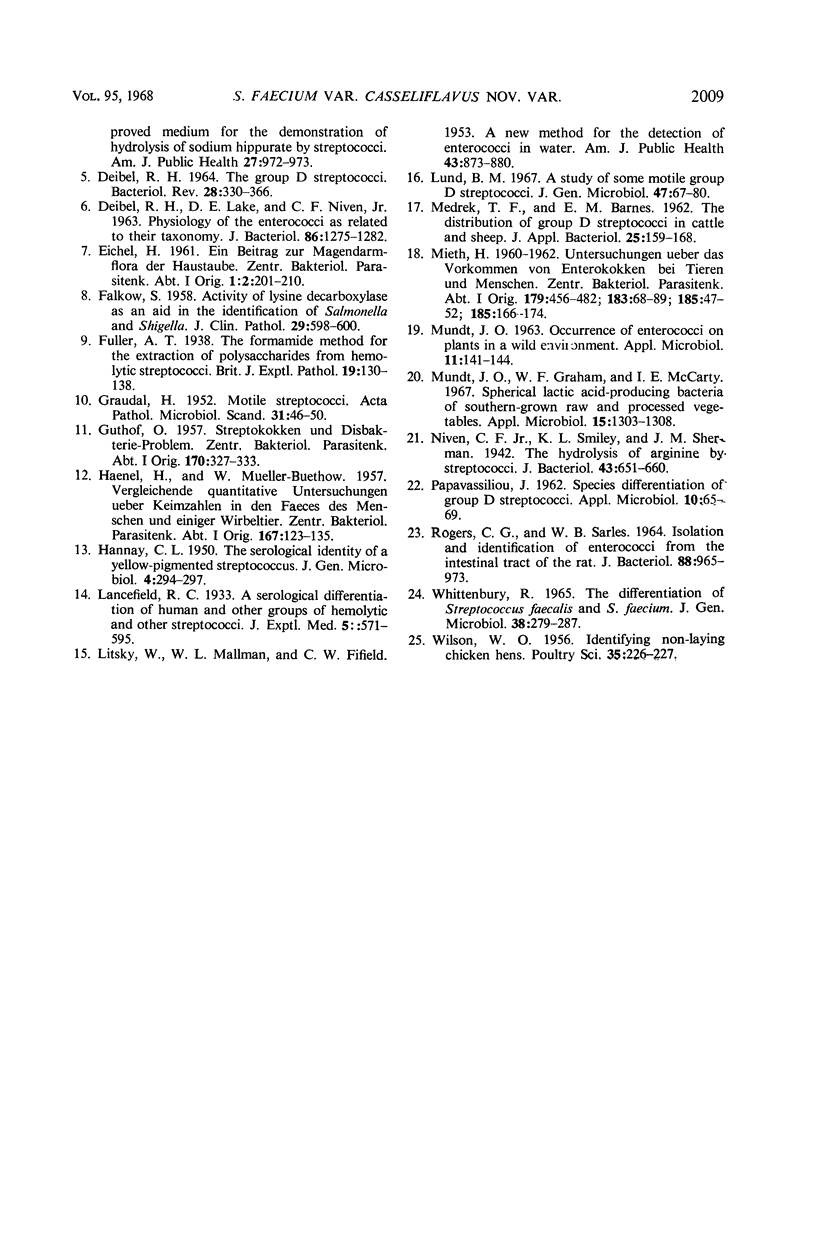Abstract
Streptococcus faecium var. casseliflavus is a gram-positive, spherical cell. The cells occur chiefly as pairs within chains and elongate to ogive-shaped cells during growth. Growth is good on 5% bile salts-agar and in broth at 10 C, and in broth adjusted to pH 9.6 or containing 6.5% NaCl, but many strains fail to grow at 45 C. Litmus is reduced rapidly prior to formation of an acid curd. Few strains release ammonia from arginine or serine. The organism is not proteolytic and does not produce H2S or acetylmethylcarbinol, reduce nitrate, decarboxylate tyrosine, or produce slime on sucrose-agar. Most strains survive heating to 60 C for 30 min. It produces gray colonies on potassium tellurite agar, reduces 2,3,5-triphenyltetrazolium-HCl to a pink color, and ferments cellobiose, dextrin, maltose, mannose, and sorbitol, thus resembling S. faecalis. Like S. faecium, it produces peroxidase but not catalase on heated blood media, dissimilates malate, and ferments arabinose, melibiose, and salicin, but not melezitose. Like both species, it ferments dextrose, galactose, lactose, mannitol, sucrose, trehalose, and citrate. Properties peculiar to the variant include the high pH limiting initiation and termination of growth; the fermentation of α-methyl-d-glucoside, raffinose, and xylose; motility; and growth without blue button formation in ethyl violet broth. The water-soluble, pale lemon-yellow pigment is released into the aqueous phase only after the cell envelope is altered by fat solvents. The bacterium thrives as an epiphyte on plants.
Full text
PDF




Images in this article
Selected References
These references are in PubMed. This may not be the complete list of references from this article.
- BARNES E. M. Tetrazolium reduction as a means of differentiating Streptococcus faecalis from Streptococcus faecium. J Gen Microbiol. 1956 Feb;14(1):57–68. doi: 10.1099/00221287-14-1-57. [DOI] [PubMed] [Google Scholar]
- Ball R. J., Sellers W. Improved motility medium. Appl Microbiol. 1966 Jul;14(4):670–673. doi: 10.1128/am.14.4.670-673.1966. [DOI] [PMC free article] [PubMed] [Google Scholar]
- DEIBEL R. H., LAKE D. E., NIVEN C. F., Jr PHYSIOLOGY OF THE ENTEROCOCCI AS RELATED TO THEIR TAXONOMY. J Bacteriol. 1963 Dec;86:1275–1282. doi: 10.1128/jb.86.6.1275-1282.1963. [DOI] [PMC free article] [PubMed] [Google Scholar]
- DEIBEL R. H. THE GROUP D STREPTOCOCCI. Bacteriol Rev. 1964 Sep;28:330–366. doi: 10.1128/br.28.3.330-366.1964. [DOI] [PMC free article] [PubMed] [Google Scholar]
- FALKOW S. Activity of lysine decarboxlase as an aid in the identification of Salmonellae and Shigellae. Am J Clin Pathol. 1958 Jun;29(6):598–600. doi: 10.1093/ajcp/29.6_ts.598. [DOI] [PubMed] [Google Scholar]
- GRAUDAL H. Motile Streptococci. Acta Pathol Microbiol Scand. 1952;31(1):46–50. doi: 10.1111/j.1699-0463.1952.tb05052.x. [DOI] [PubMed] [Google Scholar]
- GUTHOF O. Streptokokken und Dysbakterie-Problem. Zentralbl Bakteriol Orig. 1957 Nov;170(1-5):327–333. [PubMed] [Google Scholar]
- HANNAY C. L. The serological identity of a yellow-pigmented Streptococcus. J Gen Microbiol. 1950 Sep;4(3):294–297. doi: 10.1099/00221287-4-3-294. [DOI] [PubMed] [Google Scholar]
- LITSKY W., MALLMANN W. L., FIFIELD C. W. A new medium for the detection of enterococci in water. Am J Public Health Nations Health. 1953 Jul;43(7):873–879. doi: 10.2105/ajph.43.7.873. [DOI] [PMC free article] [PubMed] [Google Scholar]
- Lund B. M. A study of some motile group D streptococci. J Gen Microbiol. 1967 Oct;49(1):67–80. doi: 10.1099/00221287-49-1-67. [DOI] [PubMed] [Google Scholar]
- MUNDT J. O. Occurrence of enterococci on plants in a wild environment. Appl Microbiol. 1963 Mar;11:141–144. doi: 10.1128/am.11.2.141-144.1963. [DOI] [PMC free article] [PubMed] [Google Scholar]
- Mundt J. O., Graham W. F., McCarty I. E. Spherical Lactic Acid-producing Bacteria of Southern-grown Raw and Processed Vegetables. Appl Microbiol. 1967 Nov;15(6):1303–1308. doi: 10.1128/am.15.6.1303-1308.1967. [DOI] [PMC free article] [PubMed] [Google Scholar]
- Niven C. F., Smiley K. L., Sherman J. M. The Hydrolysis of Arginine by Streptococci. J Bacteriol. 1942 Jun;43(6):651–660. doi: 10.1128/jb.43.6.651-660.1942. [DOI] [PMC free article] [PubMed] [Google Scholar]
- ROGERS C. G., SARLES W. B. ISOLATION AND IDENTIFICATION OF ENTEROCOCCI FROM THE INTESTINAL TRACT OF THE RAT. J Bacteriol. 1964 Oct;88:965–973. doi: 10.1128/jb.88.4.965-973.1964. [DOI] [PMC free article] [PubMed] [Google Scholar]
- WHITTENBURY R. THE DIFFERENTIATION OF STREPTOCOCCUS FAECALIS AND S. FAECIUM. J Gen Microbiol. 1965 Feb;38:279–287. doi: 10.1099/00221287-38-2-279. [DOI] [PubMed] [Google Scholar]



